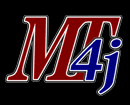all pages
| wiki | search |
Contents |
Gesture support
MT4j already provides a set of the most common multi-touch gestures. Be aware that in some countries (e.g. the US) multi-touch gestures are protected by patents.
Gesture processors for object manipulation
 |
The tap gesture is the equivalent of a mouse click. It can be triggered on an object by touching it and removing the finger again. |
 |
An object can be dragged to another location by putting a cursor down on the object and then moving it to a new location. The Object will stay under the cursor for the whole time. |
 |
With this very intuitive two finger gesture you can rotate an object around its z-axis. This gesture is very easily illustrated by imagining a paper lying on a desk, putting two fingers on it and then rotating the paper with your fingers. It is the users decision whether to use one or two hands for this gesture. |
 |
Scalable objects can be resized by moving two fingers in a different direction. Scaling and rotating objects can be performed simutanously. |
Gesture processors for background manipulation
 |
This gesture allows to zoom in or out by moving the camera position. Similar to the scale gesture, the zoom amount is determined by the distance between two fingers. The gesture has to be triggered on the background of a program to work. To avoid confusion at multi user scenarios, only one active zoom gesture is allowed at a time.
The zoom gesture can be combined with the scroll gesture to allow easy navigation. |
 |
The camera can be moved in direction of the x-axis and y-axis by touching the background of the screen with two fingers. Both motions have to start on the background of the scene. |
 |
Lasso clustering can be used to group objects on the screen by surrounding them with one finger. Objects which have the center position within the selection are contained in the cluster. |
Creating custom gesture processors
If you want to create custom gestures have a look at the tutorials (custom gesture tutorial is planned for the future).
Page as PDF
 contact
contact
